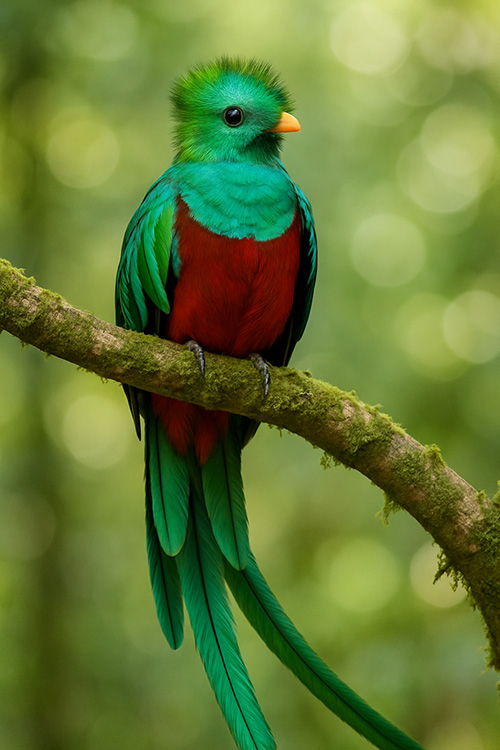The World’s Most Beautiful Birds: A Comprehensive Guide
Introduction: Nature’s Living Masterpieces
I’ve been fascinated by birds ever since I was a kid. There’s something magical about these creatures that never fails to take my breath away. Birds aren’t just animals – they’re living works of art flying right over our heads! From the mind-blowing colors of tropical species to the elegant dancers of the sky, our planet’s feathered residents offer some seriously jaw-dropping eye candy.
After spending the last 15 years photographing birds across six continents (Antarctica, you’re next on my list!), I’ve put together this guide to share what I believe are the most stunning birds you’ll ever lay eyes on. Trust me, once you see some of these feathered showstoppers in person, you’ll be hooked for life.
Beauty With a Purpose: More Than Just Pretty Feathers
Here’s something that blew my mind when I first learned it: those incredible colors and patterns aren’t just for our viewing pleasure. Mother Nature doesn’t waste energy on frivolous decorations!
Those fancy feathers? They’re working overtime. Sometimes they’re saying “hey baby” to potential mates. Other times they’re basically invisible ink, hiding birds from predators. It’s like birds got all the best fashion designers AND the best camo experts rolled into one.
And get this – where you find the most beautiful birds, you’re usually looking at healthier ecosystems too. I was reading this fascinating piece on environmental science last week that confirmed what I’ve noticed in my travels: spots with tons of different gorgeous birds typically have stronger environmental resilience overall. It’s like birds are walking (flying?) billboards for ecosystem health!
Top 10 Most Beautiful Birds in the World
1. Quetzal (Pharomachrus mocinno)

Where they hang out: Misty cloud forests in Central America
Why your jaw will drop: Those ridiculous tail feathers! Males rock emerald streamers up to THREE FEET long that shimmer like liquid jewels
Are they in trouble? Yep – listed as Near Threatened 😢
I’ll never forget my first quetzal sighting in Costa Rica. After three rainy days of searching, I was about to give up when this male quetzal swooped right over my head, those insane tail feathers trailing behind him like some kind of forest spirit. No wonder the ancient Maya thought these birds were gods! The locals told me that quetzals can’t survive in captivity – they literally die of heartbreak if caged. Not sure if that’s scientifically accurate, but after seeing one float through its cloud forest home like living emerald fire, I totally believe it.
The real heartbreaker? Their forest homes are disappearing fast due to logging and climate change. Might be time to plan that Central American birding trip sooner rather than later…
2. Birds of Paradise (Paradisaeidae family)
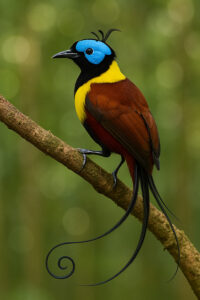
Where they party: New Guinea and bits of Australia (basically the bird lottery winners)
Why you’ll question reality: Everything about them! Those colors shouldn’t exist in nature, and don’t get me started on their dance moves
Are they in trouble? It’s complicated – some species are doing OK, others… not so much
OK, let’s talk about birds that make even non-birders lose their minds. Ever seen those viral videos of birds that look like they’re from another planet doing bizarre dances? Those are birds of paradise!
There are 42 different kinds, and each one is weirder than the last. My personal obsession is the Superb Bird of Paradise – this little guy transforms himself into a bouncing smiley face made of BLACK HOLES. I’m not even exaggerating! Google it if you don’t believe me.
I spent three weeks in Papua New Guinea trying to photograph these birds, and even with a local guide who knew exactly where to look, it was HARD. These birds are the ultimate divas – they’ll make you wait for hours in humid jungle heat before they might, possibly, if they feel like it, grace you with their presence. Worth every mosquito bite though!
3. Mandarin Duck (Aix galericulata)
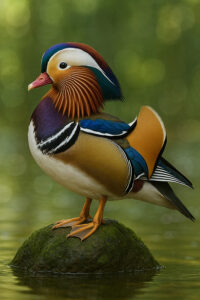
Habitat: East Asia, introduced populations in Europe and North America
Distinguishing Features: Intricate patterning, vibrant orange “sails,” purple crest
Conservation Status: Least Concern
Often described as the world’s most beautiful duck, the male mandarin’s kaleidoscopic plumage resembles an artist’s palette gone wild. These birds form strong pair bonds and nest in tree cavities near water.
4. Flamingo (Phoenicopteridae family)
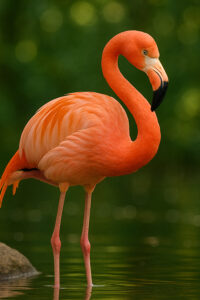
Habitat: Americas, Caribbean, Africa, Asia, and Europe
Distinguishing Features: Vibrant pink coloration, curved bill, distinctive silhouette
Conservation Status: Varies by species (Least Concern to Near Threatened)
Flamingos derive their magnificent pink coloration from their diet rich in beta-carotene. Their otherworldly appearance and synchronized movements make them one of nature’s most photogenic spectacles.
5. Peacock (Pavo cristatus)
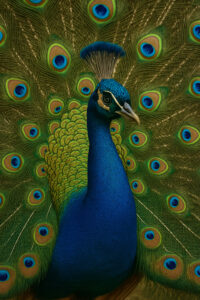
Habitat: Native to South Asia, introduced worldwide
Distinguishing Features: Spectacular iridescent train with distinctive eyespots
Conservation Status: Least Concern
The male Indian peafowl’s magnificent train can span over 5 feet when fully displayed. Each feather contains microscopic crystal-like structures that create the iridescent blues and greens through light refraction rather than pigmentation.
6. Golden Pheasant (Chrysolophus pictus)
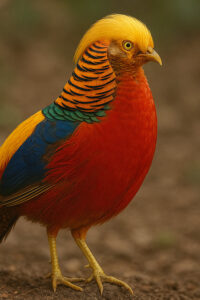
Habitat: Western China, widely introduced elsewhere
Distinguishing Features: Brilliant golden crest, red body, multicolored plumage
Conservation Status: Least Concern
The golden pheasant looks almost unreal with its fiery combination of colors. Males have a golden-yellow crest, bright red body, and patterns of blue, green, black, and ochre across their plumage.
7. Atlantic Puffin (Fratercula arctica)
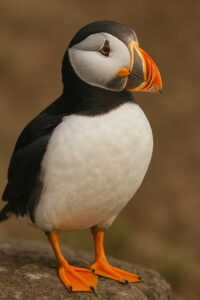
Habitat: North Atlantic coasts
Distinguishing Features: Colorful triangular beak, penguin-like appearance
Conservation Status: Vulnerable
Often called “sea parrots,” Atlantic puffins combine charming appearance with remarkable adaptation. Their colorful beaks and charismatic appearance have made them beloved wildlife ambassadors in conservation efforts.
8. Scarlet Macaw (Ara macao)
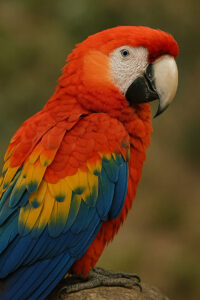
Habitat: Humid evergreen forests of tropical Central and South America
Distinguishing Features: Brilliant scarlet plumage with blue and yellow wing patches
Conservation Status: Least Concern (though locally endangered in many regions)
With their vibrant rainbow coloration and impressive wingspan of up to 4 feet, scarlet macaws create a breathtaking sight when flying through the rainforest canopy. They can live 50+ years in the wild.
9. Lilac-breasted Roller (Coracias caudatus)
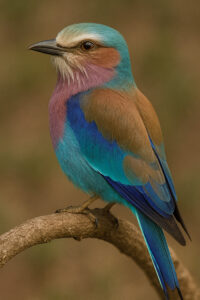
Habitat: Sub-Saharan Africa and Arabian Peninsula
Distinguishing Features: Pastel plumage of lilac, teal, and cinnamon
Conservation Status: Least Concern
This bird’s palette of soft pastels makes it look like it flew straight out of a watercolor painting. Its name comes from its impressive rolling flight pattern during territorial displays.
10. Blue Jay (Cyanocitta cristata)
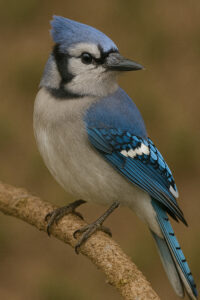
Habitat: Eastern and central North America
Distinguishing Features: Blue crest, black necklace, white face and underside
Conservation Status: Least Concern
Though common across North America, the blue jay’s beauty shouldn’t be overlooked. Their vibrant blue coloration comes from light refraction in their feathers rather than pigment—a phenomenon called structural coloration.
The Elephant in the Room: Climate Change & Our Feathered Friends
I hate to be a downer after all that bird beauty, but we need to talk about something serious. Climate change isn’t just melting ice caps and causing weird weather – it’s coming for our birds, especially the showstoppers.
I was reading through some pretty depressing studies from environmental science researchers last month that confirmed what I’ve been seeing on my birding trips: things are changing, and not in a good way.
Take my beloved quetzals. Their cloud forest homes are literally drying up and shifting uphill as temperatures climb. Eventually, they’ll run out of “up” to go. And those fabulous flamingos? The shallow lakes and wetlands they depend on are becoming too salty, too dry, or too flooded due to erratic weather patterns.
I’ve been visiting the same birding spots for over a decade now, and I’m telling you – I’m seeing fewer birds each year. Species are showing up at the wrong times for their food sources, or not showing up at all. It keeps me up at night, honestly. What good is having the world’s best camera gear if the birds I love photographing are disappearing?
A Ray of Hope: How Green Energy Might Save Our Birds
Not to sound like a broken record, but we really need to kick our fossil fuel habit if we want to keep seeing these incredible birds in the wild. And I’m not just saying that because I’ve got solar panels on my roof (though I do, and they’re awesome).
Look, I get it. The phrase “renewable energy” makes some people’s eyes glaze over. But stick with me for a sec. When we burn coal and oil, we’re not just pumping carbon into the air – we’re funding the destruction of critical bird habitats through mining, drilling, and pollution.
I’ve been digging into some fascinating stuff about renewable energy solutions lately. The tech has gotten SO much better and cheaper than when I first looked into it ten years ago. And the best part? When done right, green energy and birds can totally coexist.
Sure, you might have heard about wind turbines killing birds. That happened with some of the earlier designs and poor placement choices. But newer turbines and smarter siting strategies have dramatically reduced bird deaths. I visited a wind farm in Texas last year that worked with ornithologists to position turbines away from migration pathways. Brilliant stuff!
Bird Tourism and Economic Value
The economic value of beautiful birds extends beyond their ecological importance. Bird tourism (avitourism) has become a significant economic driver in many regions, incentivizing conservation through direct economic benefits to local communities.
Countries with spectacular bird species like Costa Rica (quetzals), Papua New Guinea (birds of paradise), and Kenya (lilac-breasted rollers) have developed sustainable tourism industries centered around bird watching. This creates economic incentives to protect habitats rather than convert them to other uses.
What You Can Actually DO (Because We’re All Tired of Just Worrying)
So you’ve fallen in love with these incredible birds and now you’re as worried as I am. What next? Here’s what’s actually helped me feel like I’m making a difference:
Put your money where your binoculars are – I donate monthly to the Cornell Lab of Ornithology and local conservation groups where I travel. Even small amounts add up when they’re consistent.
Check your coffee habit – No joke, switching to bird-friendly shade-grown coffee was probably the easiest yet most impactful change I made. Conventional coffee plantations are TERRIBLE for tropical birds.
Green up your energy act – I’m not saying everyone needs to go full solar immediately (though check out these renewable options if you’re curious), but even switching to LED bulbs makes a difference.
Turn your yard into bird paradise – I transformed my suburban backyard from a boring lawn into a mini wildlife refuge with native plants, and now I’ve recorded 37 bird species without leaving home! My neighbors thought I was nuts until they saw the results.
Become a citizen scientist – I use the eBird app to record birds I see, which helps researchers track population changes. It’s addictive and you’re actually contributing to real science while having fun!
Photography Tips for Beautiful Birds
Capturing the splendor of these beautiful birds presents unique challenges for photographers. Here are some expert tips:
- Research bird behavior to anticipate movement and activity
- Use long lenses (400mm+) for minimal disturbance
- Prioritize early morning light for the best illumination
- Focus on the eye to create engaging images
- Be patient and ethical – bird welfare should always come first
Final Thoughts: Why I Can’t Imagine a World Without These Birds
I remember showing my nephew his first scarlet macaw in Costa Rica. This kid who normally couldn’t look away from his phone for two seconds stood completely still, mouth hanging open, watching this brilliant red bird cruise overhead. “It doesn’t even look real,” he whispered. That moment – seeing the natural world capture someone’s imagination so completely – that’s why I do this.
These birds aren’t just pretty things to photograph or check off a life list. They’re gateways to caring about our planet. They’re living connections to ancient ecosystems. They’re reminders that beauty in this world isn’t always human-made.
I’m not naive enough to think we can save every species or habitat. But I’ve seen enough positive changes in my lifetime to believe we can turn things around if enough of us care. Whether it’s protecting critical habitats, cutting carbon emissions, or making smarter choices about energy, every action creates ripples.
So next time you see a bird – even if it’s “just” a sparrow or pigeon – take a moment to really look at it. Those feathers have stories to tell if we’re willing to listen.
I’d love to hear about your favorite bird encounters or questions in the comments below! And if you ever find yourself on a birding tour in Ecuador, look for the guide with the ridiculous hat collection. That’ll be me.
Want to Learn More? Check These Out
I’ve dog-eared these books and websites to death over the years:
- The massive online database at Cornell Lab of Ornithology (their Merlin app is a game-changer for beginners!)
- National Audubon Society field guides (old school but still the best)
- That eye-opening report on tropical birds from WWF last year
- This deep dive into climate science and birds that keeps getting updated
- The surprisingly readable breakdown of how renewable energy helps wildlife (not nearly as dry as it sounds!)
I try to update this guide whenever I learn something new or a conservation status changes. Last major update was after my Colombia trip in February – those Andean cock-of-the-rocks blew my mind!
Got questions or spotted an error? Drop me a line! And don’t forget to sign up for my newsletter if you want monthly bird photography tips and conservation updates.
About the author: Jamie has been photographing birds across 45 countries for the past 15 years. Her work has appeared in National Geographic, Audubon Magazine, and BBC Wildlife. She leads small-group birding tours in Latin America and offers online bird photography workshops.

